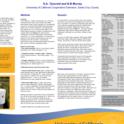Spring 2011: Light brown apple moth management in nursery stock: Mating disruption control strategy proven useful but incomplete
Regional Report for Santa Cruz and Monterey Counties by Steve Tjosvold
Our research project in local ornamental nurseries demonstrates the useful but incomplete effectiveness of using pheromone mating disruption for the management of light brown apple moth (LBAM) in typical Santa Cruz County nurseries. Conventional wisdom has shown that, in general, a mating disruption treatment should be used on a contiguous production area that is 10 acres or greater. For LBAM management, mating disruption (with pheromone “twist ties”) has been successful in these type of production areas such as vineyards and citrus in Australia, or recently, in the large berry fields of Watsonville. In our experiments, we wanted to see whether the control strategy would work in local nurseries, where nurseries are typically smaller than the 10-acre recommended area.
We found that mating disruption was useful in reducing LBAM, but we also found LBAM on plant hosts that surrounded these nurseries on ornamentals, weeds and native plants. Because many of the LBAM detections on production plants were located near nursery perimeters, we believe that fertile moths from these infested areas could be migrating into nurseries and confound the success of pheromone mating disruption and other management strategies.
We developed and used bait traps to evaluate pheromone mating disruption and generally monitor LBAM populations in and around nurseries. We found that bait traps using solutions of vinegar, terpinyl acetate (a food additive) + brown sugar, or portwine can be useful for monitoring LBAM adult populations, although their rate of capturing insects is lower than commercial synthetic pheromone traps and ultraviolet light traps. A greater proportion of female moths are attracted to the bait traps than to ultraviolet traps, which is an advantage, and commercial pheromone traps only capture male moths.
Bait traps can be used to monitor for LBAM even when mating disruption is employed. Bait and pheromone traps are inexpensive and relatively easy to maintain. Ultraviolet light traps are expensive and work best when they can be powered by an AC power source, so they are not adaptable to many field monitoring situations. For more information about this project and details on the baits and design of the traps click on the thumbnail below or see http://ucanr.org/sites/UCNFAnews/newsletters/Download_UCNFA_News_as_PDF33434.pdf.
We recently submitted a grant proposal to improve the LBAM mating disruption strategy and develop other IPM strategies. We now are prepared to evaluate the use of bait traps and other traps to mass trap and kill migrating moths at nursery perimeters. Also, sterilized moths from the USDA should be available by next year, and we propose to apply these moths at or near nursery perimeters. We believe that the combined effect of pheromone mating disruption strategy with twist ties and the use of sterile moth releases at nursery perimeters will broaden control beyond nursery boundaries. This should help reduce successful mating and the migration of fertile female moths into the nursery.













